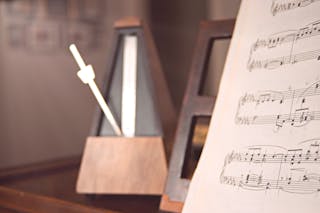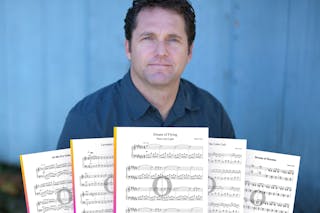The 25 most famous classical piano pieces, from easy to difficult

Jump to section
You get a fascinating chord poster + exclusive content!
Famous Classical piano pieces for beginners
When you think of "piano pieces for beginners", do boring, monotonous finger exercises spring to mind? They don't have to be. There is fantastic, beautiful, enchanting piano literature for beginners out there!
In the video below, there's a perfect example - the Canon in D! Although originally for strings, you can absolutely slay Pachelbel's most famous piece on the piano:
- The harmonies of Erik Satie's Profiter de ce qu’il a des cors aux pieds pour lui prendre son cerceau leap from the keys in pretty chord arrangements. This cheerful piece by the French pianist and composer is easy to play because the harmonies keep repeating themselves in regular eighth notes.
- Johann Pachelbel's Canon in D is also based on repetition. In this case, it is the famous bass line that constantly recurs while the theme and its variations unfold in the upper voice. If you want to learn this piece step by step with a real instructor, we also have a special Canon in D tutorial for you!
- Johannes Brahms' Lullaby, Op. 49, No. 4 is also known as "Guten Abend, Gut' Nacht", and one of the most popular lullabies. In the piano version, the beautiful flowing melody shines like the evening star.
- Camille Saint-Saëns' "The Swan" (from the "Carnival of the Animals") is one of his best-known works. "The Carnival of the Animals" was written in 1886, originally as a private composition for friends, with precise instructions that it was not to be published during the French composer's lifetime - except "The Swan". The slow piece in G-Major is magnificently elegant and flowing.
- Yes, even beginners can play Johann Sebastian Bach! The Prelude No. 1 in C-Major, BWV 846 charms with beautiful chord progressions.
- Franz Schubert's Ave Maria was composed in 1825 and was originally part of his Op. 52, called "Ellen's Third Song", a collection of seven songs inspired by Sir Walter Scott's poem "The Lady of the Lake".
- Christian Petzold's Minuett in g-Minor, BWV Anh. 115, was originally attributed to J.S. Bach, as it was published in the latter's "Notenbüchlein für Anna Magdalena Bach". Only later, the Dresden organist and contemporary of Bach was identified as the true composer.
Famous Classical Piano Pieces for Intermediate Players
Have you already got some experience on the piano? Or did you play quite well back in the day and you're just working your way back to that stage? Then these are for you.
Here's one of our intermediate favorites:
These piano pieces take you through eras and styles. The one thing they have in common is their popularity. Which one do you know? And which of these do you want to try?
- Erik Satie: Gnossienne No. 1. Nobody knows what a "Gnossienne" is, but we do know how it sounds! This 19th-century piece allows for much variation in expression and tempo.
- Wolfgang Amadeus Mozart: Piano Sonata No. 16 in C-Major, 3. Allegretto. Mozart got it in his head to write a sonata "for beginners". We end up with a cheerful, lively piece, but by far not as easy as Mozart - being the genius he was - assumed. However, mastering this 3rd movement is entirely within the range of your abilities as an intermediate player!
- Ludwig van Beethoven: Für Elise. You won't find any other piano piece as instantly recognizable as this one! We have a step-by-step "Für Elise"-tutorial if you need support learning how to play it.
- Frédéric Chopin: Raindrop-Prélude, Op. 28 No. 15. Chopin composed this wonderful piece in Db-Major 1839 not, as the title might suggest, in pouring rain, but on the rather dry Mediterranean island of Majorca.
- Domenico Scarlatti: Sonata in f-Minor, K466 (L.118). Did you know that this baroque composer was likely the first of the great masters who played his piano pieces on an actual piano?
- Robert Schumann: His Träumerei is the embodiment of romantic piano music!
- Wolfgang Amadeus Mozart: Piano Sonata No. 11 in A-Major, KV331 (300i): 3. Allegretto - Rondo "Alla Turca". Mozart's "Turkish March" is one of the most beloved Classical pieces of all time - go for it and have fun!
- Ludwig van Beethoven: Sonata quasi una Fantasia ("Moonlight Sonata"). Liszt is rumored to have strictly forbidden his students ever to play the Moonlight Sonata. He argued it should only be performed if played perfectly - and Liszt himself was presumably one of the few people able to do that. We, however, encourage you to learn this piece! Every beginning is hard, true enough - but once you have mastered this piece you can play one of the most beautiful works of piano literature!
- Edvard Grieg: The peaceful "Morning Mood" from the "Peer Gynt"-Suite is not quite a piece of cake to play, but well worth the effort.
- Frederic Chopin: Etude in E-Major, Op. 10 No. 3 ("Tristesse"). In Chopin's humble opinion, this is the most beautiful melody he ever composed. Who are we to contradict him?
Famous Classical Piano Pieces for Advanced Players
The next six pieces by Debussy, Mozart, Beethoven, Chopin, and Ravel are among the most beautiful and famous piano music ever written. If you would like to play them but find them a bit too hard: We have simplified arrangements available at OKTAV and would like to encourage you to try them!
Here's one of our favorites - Clair De Lune by Claude Debussy:
- Claude Debussy: Clair de Lune. Originally the third movement of the Suite Bergamasque, this dream-like piece is the moonray-like embodiment of Impressionism.
- Wolfgang Amadeus Mozart: Piano Sonata No. 16 in C-Major, KV545, 1. Allegro. You've tackled the third movement earlier (see above) - now you're ready to master the very famous first movement!
- Ludwig van Beethoven: Piano Sonata No. 17, Op. 31 Nr. 2 III (Allegretto). The "Tempest Sonata" got its name from a remark by Beethoven. He told his secretary that the key to understanding this piece lies within Shakespeare's "The Tempest".
- Frédéric Chopin: Nocturne in Eb-Major, Op. 9 No. 2. Lyrical, expressive, romantic - this is everyone's favorite nocturne by Chopin. If this version is a bit too hard, you can take a step-by-step Nocturne tutorial.
- Maurice Ravel: Pavane pour une infante défunte. A slow dance across the keyboard. not written for any particular princess but for the listeners' hearts!
Famous Classical Piano Pieces for Virtuosi
Found the pieces up to this point a trifle too easy to play? We hear you, loud and clear. These two Classical masterpieces are not for the faint-fingered:
- Ludwig van Beethoven: Grande Sonate Pathetique, Op. 13: 1 Grave/Allegro di molto e con brio. Beethoven was only 27 years of age when he composed one of his most magnificent works, the "Pathetique". He had already developed his typical style - and this given us a composition full of churning passion, or "pathos". Hence the name.
- Frédéric Chopin: Prélude in f#-minor, Op. 28 No. 8. Chopin was heavily influenced by J.S. Bach when he wrote the Préludes Op. 28. Just like in Bach's "Wohltemperiertes Klavier", he composed and arranged the pieces in every scale of the circle of fifths. Prélude No. 8 will - figuratively - let you grow wings on your fingers.
Well, now you know our selection of 25 Classical Favorites, sorted from "easy" to "challenging". Which pieces do you like best? Or have we missed a piece that you think should be on that list? You'll certainly find it on our list of Classical piano pieces!


